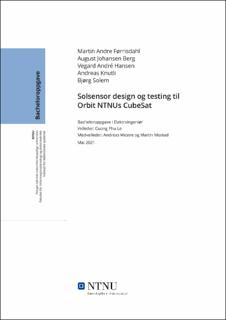Solsensor design og testing til Orbit NTNUs CubeSat
Berg Johansen, August; Førrisdahl, Martin Andre; Hansen, Vegard André; Knutli, Andreas; Solem, Bjørg
Bachelor thesis
Permanent lenke
https://hdl.handle.net/11250/2778180Utgivelsesdato
2021Metadata
Vis full innførselSamlinger
Sammendrag
Bachelor-gruppen har hatt som mål å designe og kalibrere en prototype solsensor med Field of View på 60°. Solsensorer er kommersielt sett veldig kostbare, av denne grunnen ønsker Orbit å designe og produsere disse in-house. For å oppnå dette har gruppen forsket på teorien bak forskjellige tilnærminger til problemet, og gjennom vårsemesteret 2021 designet en solsensor som er basert på en fire-kvadrant lysdiode. Selve sensoren kalibreres med en kalibreringsrigg med to frihetsgrader som er av gruppens eget design, og i tillegg til dette har gruppen en rekke andre kostnadsbesparende løsninger. Gruppen har simulert forventet resultater i MATLAB, og legger fram de faktiske målingene fra sensoren. Deretter diskuteres og sammenlignes disse, og gruppen konkluderer med at oppgaven er fullt gjennomførbar, men at noen uheldige omstendigheter gjorde at målet ikke ble fullstendig nådd. Som siste del av rapporten skrives det om framtidig arbeid, og hva gruppen mener Orbit bør gjøre som neste steg i prosessen. The bachelor group was tasked with designing and testing of a prototype sun sensor with a Field of View of 60°. Commercial sun sensors are a considerable expense, therefore Orbit wanted the option to produce them in-house. To accomplish this goal the group had to research different approaches on how to solve the problem, and throughout the spring semester of 2021 they designed a sun sensor based on a four quadrant photodiode. The sensor is tuned by a calibration rig with two degrees of freedom of the groups own design. They have in addition to this devised a number of other cost saving measures. The group has simulated expected values from the sensor through MATLAB, and provided actual data from the sensor. These datasets are then analyzed and compared, and the group reaches the conclusion that the thesis is fully feasible, and that unfortunate circumstances lead to the goal not being fully met. The rest of the thesis is dedicated to future work, and the groups thoughts on Orbits path forward regarding sun sensor design.
